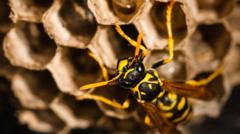The Savannah River Site (SRS), a former nuclear weapons production facility located near Aiken, South Carolina, recently made headlines following the discovery of a radioactive wasp nest that recorded radiation levels ten times above federal safety limits. According to a report released last week by the Energy Department, the nest was uncovered during routine inspections aimed at monitoring nuclear radiation at the site.
On July 3, workers encountered the hazardous nest situated on a post in close proximity to tanks holding millions of gallons of liquid nuclear waste. Despite this alarming find, federal officials swiftly assured the public that there was no leak from these tanks and attributed the high radiation levels found on the nest to "onsite legacy radioactive contamination." This term refers to residual radioactivity remaining from the facility’s operational days during the Cold War when it was engaged in producing components for nuclear weapons.
The Energy Department report clarified that while the wasps residing within the nest would have harbored much lower levels of radiation than the nest itself, concerns remain about the implications of such contamination. The study emphasized that wasps typically do not venture far from their nests, indicating that the likelihood of exposure to the surrounding community was minimal. It explicitly stated that "No contamination was found in the area," and confirmed that "there were no impacts to workers, the environment, or the public."
However, watchdog organization Savannah River Site Watch expressed frustration over the lack of clarity regarding the origin of the radioactive materials. Spokesman Tom Clements voiced concerns, asking where the contamination originated and whether there was a potential leak from the waste tanks that could pose a risk to the public.
The SRS has a history of handling large quantities of nuclear waste, generating over 165 million gallons in the past, with 43 underground storage tanks still in operation today, while eight others have been closed. As the investigation continues, community members and environmental advocates are calling for increased oversight and transparency in managing potential hazards linked to the site’s legacy activities.
On July 3, workers encountered the hazardous nest situated on a post in close proximity to tanks holding millions of gallons of liquid nuclear waste. Despite this alarming find, federal officials swiftly assured the public that there was no leak from these tanks and attributed the high radiation levels found on the nest to "onsite legacy radioactive contamination." This term refers to residual radioactivity remaining from the facility’s operational days during the Cold War when it was engaged in producing components for nuclear weapons.
The Energy Department report clarified that while the wasps residing within the nest would have harbored much lower levels of radiation than the nest itself, concerns remain about the implications of such contamination. The study emphasized that wasps typically do not venture far from their nests, indicating that the likelihood of exposure to the surrounding community was minimal. It explicitly stated that "No contamination was found in the area," and confirmed that "there were no impacts to workers, the environment, or the public."
However, watchdog organization Savannah River Site Watch expressed frustration over the lack of clarity regarding the origin of the radioactive materials. Spokesman Tom Clements voiced concerns, asking where the contamination originated and whether there was a potential leak from the waste tanks that could pose a risk to the public.
The SRS has a history of handling large quantities of nuclear waste, generating over 165 million gallons in the past, with 43 underground storage tanks still in operation today, while eight others have been closed. As the investigation continues, community members and environmental advocates are calling for increased oversight and transparency in managing potential hazards linked to the site’s legacy activities.


















